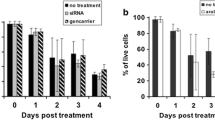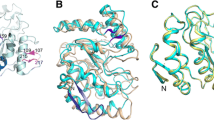Abstract
We have recently demonstrated that mammalian uracil-DNA glycosylase activity is undetectable in adult neurons. On the basis of this finding we hypothesized that uracil, derived either from oxidative deamination of cytosine or misincorporation of dUMP in place of dTMP during DNA repair by the unique nuclear DNA polymerase present in adult neurons, DNA polymerase β, might accumulate in neuronal DNA. Uracil residues could also arise in the herpes simplex 1 (HSV1) genome during latency in nerve cells. We therefore suggest a role for the virus encoded uracil-DNA glycosylase in HSV1 reactivation and in the first steps of DNA replication. We show here 1) that the viral DNA polymerase incorporates dUTP in place of dTTP with a comparable efficiencyin vitro; 2) that virus specific DNA/protein interactions between the virus encoded origin binding protein and its target DNA sequence is altered by the presence of uracil residues in its central region TCGCA. Thus uracil, present in viral OriS or other key sequences could hamper the process leading to viral reactivation. Hence, HSV1 uracil-DNA glycosylase, dispensable in viral proliferation in tissue culture, could be essential in neurons for the “cleansing” of the viral genome of uracil residues before the start of replication.
Similar content being viewed by others
References
Caradonna S. J. and Cheng Y. (1981) Induction of uracil-DNA glycosylase and dUTP nucleotidohydrolase activity in herpes simplex virus-infected human cells.J. Biol. Chem. 256, 9834–9837.
Caradonna S., Worrad D. and Liretta R. (1987) Isolation of a Herpes simplex virus cDNA encoding the DNA repair enzyme uracil-DNA glycosylase.J. Virol. 61, 3040–3047.
Challberg M. D. and Kelly T. J. Animal virus DNA replication (1989)Annu. Rev. Biochem. 58, 671–717.
Deb S. and Deb S. P. (1989) Analysis of oris sequence of HSV-1: identification of one functional DNA binding domain.Nucleic Acids Res. 17 2733–2752.
Dignam, J. D., Lebovitz, R. M. and Roeder R. G. (1985)Nucleic Acids Res., 11, 1475–1489.
Elias P. and Lehman I. R. (1988) Interaction of origin binding protein with an origin of replication of herpes simplex virus 1.Proc. Natl. Acad. Sci. USA, 85, 2959–2963.
Elias P., Gustafsson C. M. and Hammarsten O. (1990) The origin bindin protein of herpes simplex virus 1 binds cooperatively to the viral origin of replication Oris.J. Biol. Chem. 265, 17167–17173.
Focher F, Hildebrand C., Freeze S., Ciarrocchi G., Noonan T., Sangalli S., Brown N.C., Spadari S. and Wright G. (1988) N2-phenyldeoxyguanosine: a novel selective: inhibitor of Herpes symplex thymidine kinase.J. Med. Chem. 31:1496–1500
Focher F., Mazzarello P., Verri A., Hübscher U. and Spadari S. (1990) Activity profiles of enzymes that control the uracil incorporation into DNA during neuronal development.Mutation Res., 237, 65–73
Focher F., Mazzarello P., Verri A., Biamonti G. and Spadari S. (1992) Enzymatic and DNA/protein interaction studies indicate that uracil in neuronal DNA could contribute to nerve cell aging. In:Biology of aging (Zwilling R. and Balduini C. Eds), Springer-Verlag, Heidelberg, Germany, pp.8–16
Hazuda D.J., Perry H.C., Naylor A.M. and McClements W.L. (1991) Characterization of herpes simplex virus origin binding protein interaction with Oris.J. Biol. Chem. 266, 24621–24626.
Hübscher U., Kuenzle C.C., and Spadari S. (1979) Functional roles of DNA polymerase b and g,Proc. Natl. Acad. Sci. U.S.A., 76, 2316–20.
Leib D.A., Ruffner K.L., Hildebrand, C., Schaffer P.A., Wright G.E. and Coen D.M. (1990) Specific inhibition of Herpes simplex virus thymidine kinase diminish reactivation of latent virus from explanted murine ganglia.Antimicrob. Agents Chemother.34, 1285–1286.
Mazzarello P., Focher F., Verri A. and Spadari S. (1990) Misincorporation of uracil into DNA as possible contributor to aging and abiotropy of nerve cells.Internat. J. Neuroscience, 50, 169–174
Mullaney J., McL. Moss H.W. and McGeoch D.J. (1989) Gene UL2 of herpes simplex type 1 encodes a uracil-DNA glycosylase.J. Gen. Virol. 70, 449–454.
Spadari S. and Wright G. (1989) Antivirals based on inhibition of Herpes simplex thymidine kinases.Drugs News and Perspectives, 2, 333–336.
Verri A., Mazzarello P., Biamonti G., Spadari S. and Focher F. (1990) The specific binding of nuclear protein(s) to the cAMP Responsive Element (CRE) sequence (TGACGTCA) is reduced by the misincorporation of U and increased by the deamination of C.Nucl. Acids Res. 18, 5775–5780
Verri A., Verzeletti S., Mazzarello P., Spadari S., Negri M., Bunone G., Della Valle G., Hübscher U. and Focher F. (1992) DNA synthesis enzymes and proliferating cell nuclear antigen in normal and neoplastic nerve cells.Anticancer Res. 12, 1099–1106.
Waser J., Hübscher U., Kuenzle C.C., and Spadari S. (1979) DNA polymerase b from brain neurons is a repair enzyme.Eur. J. Biochem. 97, 361–368.
Weir, H.M., Calder J.M. and Stow N.D. (1989) Binding of the herpes simplex type 1 UL9 gene product to an origin of viral DNA replication.Nucleic Acids Res. 17, 1409–1425.
Weir H. M. and Stow N. D. (1990) Two binding sites for herpes simplex virus type 1 UL9 protein are required for efficient activity of ori S replication origin.J. Gen. Virol. 71, 1379–1385.
Author information
Authors and Affiliations
Rights and permissions
About this article
Cite this article
Focher, F., Verri, A., Verzeletti, S. et al. Uracil in Oris of herpes simplex 1 alters its specific recognition by origin binding protein (OBP): does virus induced uracil-DNA glycosylase play a key role in viral reactivation and replication?. Chromosoma 102 (Suppl 1), S67–S71 (1992). https://doi.org/10.1007/BF02451788
Received:
Issue Date:
DOI: https://doi.org/10.1007/BF02451788




